Introduction
The Austral or Patagonian peregrine falcon (Falco peregrinus cassini) is one of the less known subspecies of this falcon worldwide, found along the Andes Mountains, Patagonian steppes and seacoasts of southern South America (Fig 1 A, Fig 1 B).
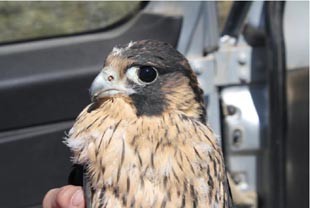
Figure 1A. The Austral or Patagonian peregrine falcon (Falco peregrinus cassini) shown A, close-up. Photograph provided by Miguel Saggese.
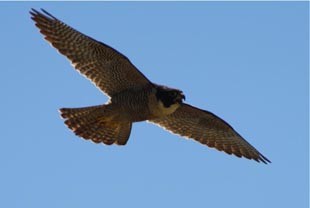
Figure 1. B The Austral or Patagonian peregrine falcon (Falco peregrinus cassini) shown B, in flight. Photograph provided by Miguel Saggese.
Why investigate the health status of Austral peregrine falcons?
The current conservation status of this falcon in Argentina is completely unknown and studies about its health status are lacking. Many species of raptors, including peregrine falcons, are globally threatened by human persecution, reduction in the availability of prey, use of pesticides, collisions with power lines and illegal commerce. Recently, the role of parasites and infections has been recognized as an additional cause of demographic changes in some wild raptors populations, including peregrine falcons. Understanding the role that diseases may play in this species’ decline in the wild may contribute to its management and conservation.
During the months of November and December 2009 we conducted field research on this species to investigate its health status in southern Patagonia, Argentina. As veterinarians interested in the role of diseases on wildlife populations, our specific goals were to:
- Establish baseline physiological reference values on hematology, serum biochemistry and plasma cholinesterases of free-ranging nestling Austral peregrine falcons;
- Investigate the prevalence of selected infectious and parasitic diseases in these birds, and
- Train Argentine veterinarians, biologists and students in biomedical sampling of birds of prey.
Hematological and clinical biochemistry reference values have not been reported for Austral peregrine falcons. These reference values are considered useful for monitoring bird’s health status, establishing disease prognosis of diseases, and evaluating responses to therapy. Toxic exposure to pesticides such as organophosphates, organochlorines, carbamates and pyrethrins is well known for contributing to the death, decreased reproduction and population decline of several species of birds of prey. Peregrine falcons worldwide have been severely affected by organochlorine use in the past century and exposure to these pesticides have been previously reported in Austral peregrine falcons. Peregrine falcons are also particularly susceptible to the use of organophosphates and strychnine. They are widely used by Patagonian ranchers as baits to kill foxes, pumas and other carnivores, including birds of prey.
The field trip
Our field trip begun in Mid-November 2009 when raptor biologists, David Ellis and Wayne Nelson, conducted surveys for active eyries (nesting sites) of Austral peregrine falcons. Our trip took us to remote locations in the Patagonian steppes (Fig 2), where we were exposed not only to the rigors of Patagonia where winds can reach 100 miles per hour and temperature can reach up to 48ºC (120º), but also to its beauties. Breathtaking landscapes and amazing wildlife are common sightings for those visiting this remote and wild area of the world. Guañacos (Lama guanicoe), Culpeo foxes (Lycalopex culpaeus), Maras or Patagonian hares (Dolichotis patagonum), Choiques or Darwin’s rheas (Rhea pennata), Magellanic geese (Chloephaga picta), Andean condors (Vultur gryphus), and buzzard eagles are all common inhabitants of the steppe.
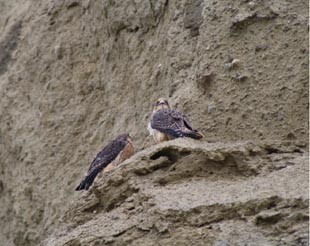
Figure 2 Austral peregrine falcon (Falco peregrinus cassini) nesting sites or eyries are found on cliffs. Photograph provided by Miguel Saggese.
Austral peregrine falcon eyries are localized in cliffs (Fig 2) so they only could be accessed using rock-climbing gear or by rappelling from the top of the cliffs (Fig 3). Many of these nest sites were previously surveyed by David Ellis and collaborators 25 years ago, but have not been revisited since then. The main goals of this survey were to evaluate nest site fidelity, count the number of active nests and collect samples for population genetic studies. All birds underwent a complete physical examination and biomedical samples including blood were collected.
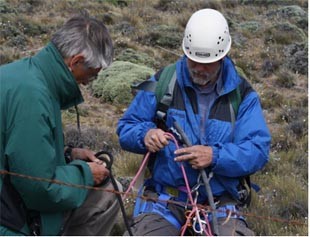
Figure 3 Our trip took us to remote locations in the Patagonian steppes where nest sites could only be accessed using rock-climbing gear or by rappelling from the top of the cliffs. Shown here are members of the research team David Ellis (right) and Dr. Wayne Nelson (left). Photograph provided by Miguel Saggese.
What are the white or pallid Austral peregrine falcons?
Austral falcons are the only subspecies of peregrine falcon worldwide that present a white or pallid color morph (Fig 4 A, Fig 4 B). This color variation was considered a different species for a long time. It was originally called Kleinschmidt’s falcon (Falco kreyemborgii) until 1980, when detailed studies by David Ellis and Cesar Garat concluded it was just a color morph of the Austral peregrine falcon. We were lucky enough to investigate several nesting sites occupied with this little known color morph. Nevertheless we still have so much to learn about Patagonian white falcons. The biology, distribution and conservation status of these birds is still mostly unknown.
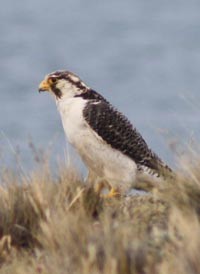
Figure 4 A Side (A) view of the white Austral peregrine falcon (Falco peregrinus cassini). Photograph by Miguel Saggese.
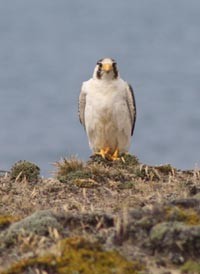
Figure 4 B Frontal (B) view of the white Austral peregrine falcon (Falco peregrinus cassini). Photograph by Miguel Saggese.
Conclusion
Our study has provided the first ever data available on baseline health parameters and reference values for the Austral peregrine falcon in South America. By combining biological data with population status the results will allow us to better assess the health status of Austral peregrine falcons in southern Argentina. Furthermore, these results will set the grounds for future monitoring of these populations. In late 2010 the whole team will head down south again to visit more nesting sites and continue our work.
Acknowledgements
This project was supported in part by generous funding provided by Lafeber Company and The Schubot Exotic Bird Health Center. Special thanks to Dr. LoraKim Joyner for all of her support and encouragement.
References
References
Ellis DH. The Austral peregrine falcon: color variation, productivity, and pesticides. National Geographic Research 1:388-394, 1985.
Newton, I. 2002. Diseases in wild bird (free-living) populations. In: Cooper JE (ed). Birds of Prey: Health and Disease. Oxford, UK